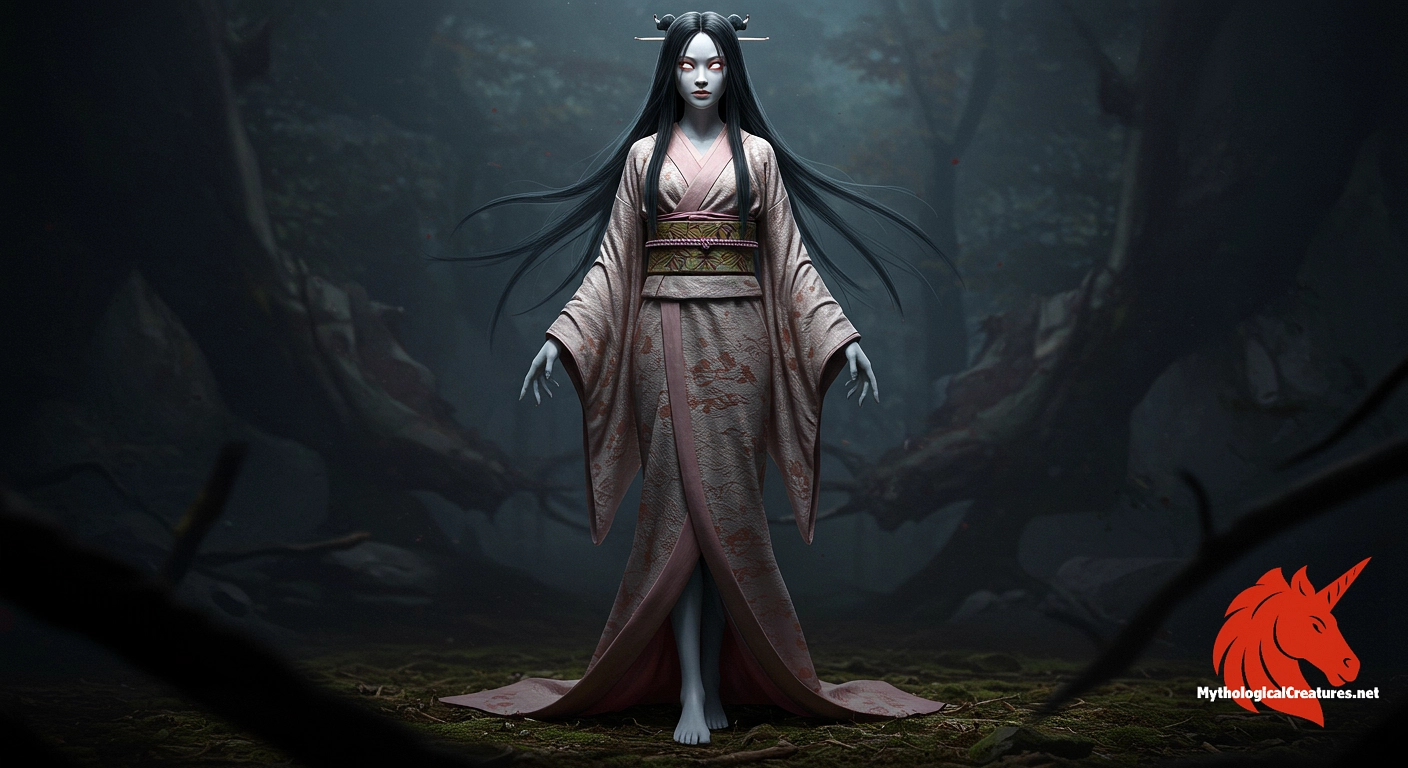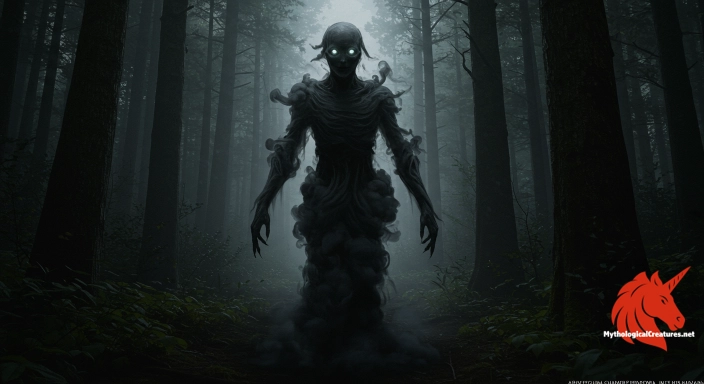Osakabehime: Osakabehime is a renowned yōkai from Japanese folklore, known for haunting Himeji Castle.

Osakabehime
Osakabehime - Osakabehime is an enigmatic figure whose legend contributes to the rich tapestry of Japanese ghost stories and theatre.
Origins & First Encounters
Osakabehime emerges as a captivating embodiment of Japanese folklore, a spectral figure whose presence imbues Himeji Castle with an air of mystery. Her origins are cloaked in enigma, with whispers that she may have once been a noblewoman touched by tragic fate before metamorphosing into the supernatural. Over centuries, her story was nurtured within the local oral traditions, eventually intertwining with the dramatic narratives of Japan’s theatrical past. The spirit inhabiting Himeji Castle is celebrated not only for her ethereal beauty but also for her multifaceted character that straddles benevolence and retribution. Her legend is deeply rooted in the cultural context of feudal Japan, where the boundary between the living and the spirit realm was often blurred. Many recount her as a guardian of the castle’s ancient corridors, while others regard her as a harbinger of sorrow and mystery. With each retelling, the legend of Osakabehime adapts, reflecting societal concerns of beauty, tragedy, and the supernatural. Her tale continues to resonate, reminding audiences of the intricate interplay between history, memory, and myth. The enduring legacy of her character underscores the cultural fascination with spirits that both haunt and heal. In this way, Osakabehime stands as a symbolic reminder of the inevitable meeting of mortal life and the timeless forces beyond it.
Source Texts & Tale Variants
The narrative of Osakabehime has been passed down through generations via diverse sources, ranging from local folklore to the dramatic presentations of the Kabuki stage. Her story achieved wider prominence when it was adapted into a Kabuki play, regarded as one of the Shin-Kabuki Jūhachiban, thereby cementing her place in the theatrical canon. Over time, script manuscripts and performance records have preserved fragments of her character, even as they imbued her tale with the emotive power of live drama. Beyond the stage, family chronicles, temple records, and the accounts of wandering storytellers have all contributed their own layers to her mythos. Each version of the story contributes fresh nuances, whether portraying her as a repentant soul or as a vengeful guardian of ancient secrets. Some regional variants speak of her in tender, almost maternal terms, while others evoke an image of a wrathful spirit exacting poetic justice. This multiplicity of sources not only reinforces her cultural significance but also exemplifies the dynamic interplay between historical record and artistic imagination. The theatrical tradition, in particular, has ensured that her narrative remains pliable and open to reinterpretation. Such fluidity has allowed her persona to evolve in parallel with shifts in societal values and aesthetic sensibilities. Ultimately, the diverse array of story variants testifies to the rich tapestry of Japanese myth, in which Osakabehime plays a central, ever-evolving role.
Form & Powers
Osakabehime is frequently depicted as an apparition of otherworldly beauty, her form shifting elegantly between the tangible and the spectral. Her appearance is often marked by long, flowing hair that seems to ripple like a silken curtain in a gentle nocturnal breeze. Eyes that reflect both sorrow and unearthly charm are a recurring motif in artistic portrayals, hinting at untold depths of emotion and regret. Many accounts describe her as emanating a soft, luminescent glow reminiscent of moonlight, a detail that accentuates her ethereal presence within the castle’s shadowy halls. Her attire is typically rendered in noble garments that evoke the refined aesthetics of a bygone era, with intricate details that suggest both grace and a certain inherent melancholy. In some depictions, her figure appears slightly elongated, a stylistic choice that underscores her status as a being caught between worlds. Variations in size and form in certain illustrations also speak to the mystical qualities of her character, where physicality becomes a canvas for symbolic storytelling. Elements such as a trailing sash that seems to dissolve into mist further contribute to the haunting beauty that defines her image. These visual attributes, while varying from one artistic tradition to the next, consistently embody the intricate blend of elegance and enigma that Osakabehime characterises. Each physical portrayal, therefore, not only captures the delicate interplay of beauty and dread but also reinforces her role as a timeless muse in Japanese mythology.
Regional Faces
While Osakabehime’s myth is intrinsically linked to Himeji Castle, her portrayal adapts fluidly across different regions of Japan, reflecting local cultural attitudes and historical experiences. In the Kansai region, where Himeji Castle itself is a prominent landmark, she is sometimes revered as a protective spirit whose presence wards off misfortune from the castle and its surroundings. Conversely, in more rural or isolated localities, the same spirit may be invoked as an omen of ill fortune or a reminder of ancestral tragedies. Variations in her narrative also emerge in nearby areas where storytellers blend her legend with local ghostly traditions, lending a unique regional flavour to her tale. Adaptations in costume, demeanour, and even the emotions she evokes can be found in diverse retellings, with some regions portraying her as a gentle guide to lost souls while others insist on her vengeful aspect. Local festivals and rituals occasionally celebrate her legacy, symbolically re-enacting her story as part of a broader cultural homage to the mysterious forces that shape life. This regional diversification underscores an inherent flexibility in her character, allowing communities to reinterpret her presence according to their own values and historical contexts. As communities across Japan both shape and are shaped by her legend, Osakabehime morphs from a fixed myth into a dynamic cultural symbol. Thus, her regional variations not only enrich her myth but also affirm the universal appeal of narratives that bridge personal tragedy with communal identity. In every corner where her story is told, the spirit of Osakabehime adapts, reflecting the localized interplay of folklore and collective memory.
Cultural Parallels
Across the vast tableau of mythological entities, Osakabehime finds intriguing parallels with numerous spectral figures from diverse cultural traditions. Her narrative, steeped in themes of beauty, tragedy, and retribution, resonates closely with the Japanese onryō, spirits renowned for their ability to bridge the gap between vengeance and melancholy. Similar to the European legend of the White Lady or the banshee, she embodies the archetype of a woman caught between life and death, her presence stirring both awe and unease. Such similarities underscore a cross-cultural fascination with spirits that emerge from untimely demises and unresolved emotions. In the East Asian context, her tale shares common ground with ghostly figures in Chinese folklore, where ancestral spirits often haunt specific landmarks imbued with historical significance. The theatrical dimension of her story also draws comparisons with mythic figures found in other dramatic traditions, wherein the supernatural serves as a catalyst for exploring themes of loss and redemption. This comparative analysis reveals that while each culture dresses its spirits in distinct attire, the universal language of myth transforms these figures into emblematic representations of fate and memory. The intersection of these elements within Osakabehime’s legend highlights a broader dialogue between regional cultures and the shared human experience with the unseen. By exploring these cultural parallels, one appreciates how her myth transcends local boundaries to become a part of a global tapestry of spectral narratives. Ultimately, Osakabehime stands not in isolation, but as a vital link in the worldwide tradition of ghostly heroines whose stories echo through the ages.
Legacy & Modern Evolution
The evolution of Osakabehime’s legend is a testament to the enduring power of myth in both historical and modern contexts. In earlier periods, her tale was carefully interwoven with the fabric of courtly and folkloric narratives during Japan’s Edo era, serving as a dramatic emblem of beauty intertwined with sorrow. Over time, as Kabuki theatre reimagined her story for an increasingly diverse audience, Osakabehime’s image was adapted to reflect changing social mores and artistic trends. The modern legacy of her myth has blossomed further through contemporary media, where anime, manga, and visual art continually reinterpret her spectral presence for a new generation. Technological advancements in stagecraft and digital media have further enhanced her mystique, reincarnating her story into immersive experiences that blur the lines between performance and reality. Her enduring relevance can also be seen in local festivals and exhibitions at Himeji Castle, where her legend is celebrated as an essential part of regional history and identity. Modern reinterpretations often imbue her character with themes of resilience and transformation, inviting audiences to engage with her narrative on both an emotional and intellectual level. Scholars and cultural commentators now explore her as a symbol of the interplay between memory and myth, highlighting how her story adapts to the spirit of contemporary times. In every creative retelling, Osakabehime remains a potent reminder of how ancient folklore continues to inform modern perspectives on identity and heritage. Thus, the historical evolution and modern legacy of her myth affirm that her story is not confined to the past, but is an ever-renewing beacon in the landscape of Japanese cultural storytelling.
Interesting Fact
Osakabehime's legend is so influential that it has secured a spot in a celebrated Kabuki play, highlighting the lasting impact of her mysterious presence on Japanese culture.
Quick Creature Info
Our Mythic Legendary Rating:

Habitat:
Supernatural Powers:
Physical Attributes:
Abilities:
Behavior:
Lore:
Related Creatures, Tales or Lore
References
Discover Another Mythical Legend You May Not Have Heard Of?
Uncover the mysteries of ancient folklore and expand your knowledge of legendary beings from cultures around the world.
Dare to Meet the Enenra....
Mythical Disclaimer: The images and data on this site are derived from various historical and literary sources, but we have found that many myths often have multiple versions and interpretations across references, sometimes contradictory. As a result, these creature depictions are artistic interpretations—imaginative blends of folklore, legend, and a dash of AI guesswork. Because creature descriptions vary widely, our illustrations and accompanying information represent our best effort to honor mythology while bridging creative gaps. Enjoy these interpretations—just remember, we've done our best to respect the stories and validate available data, but in the realm of mythology, details often shift, imagination leads the way, and nothing is ever set in stone!
Curated by the Mythological Creatures Team (rev. May 2025)
